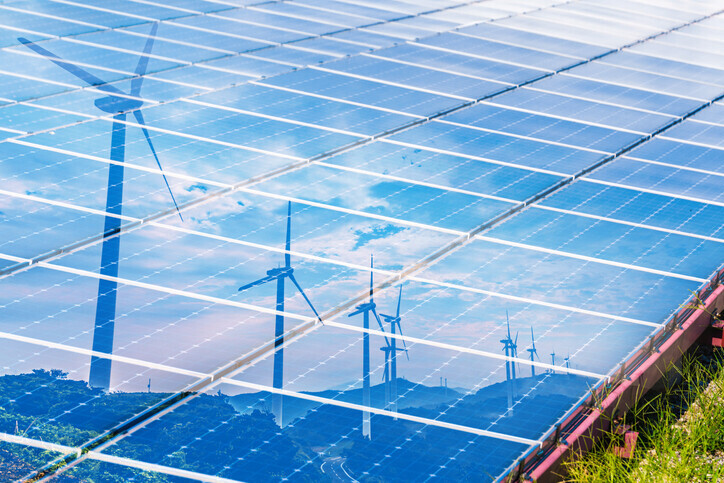hankyoreh
Links to other country sites 다른 나라 사이트 링크
[News analysis] S. Korea still embroiled in nuclear energy debate while the rest of the world moves toward renewables

An audit by South Korea’s Board of Audit and Inspection over the decision to decommission the Wolsong-1 nuclear reactor earlier than planned has rekindled the debate about the country’s phaseout of nuclear power. But experts object that this debate is counterproductive, since it clashes with many countries’ efforts to rapidly transition to renewable energy.
Other than Korea, the only major countries that are currently increasing their nuclear power capacity are China and Russia. China is simultaneously increasing renewable energy sources such as solar power and wind power, and Russia is mostly increasing nuclear power with the goal of exporting to countries in Eastern Europe.
While the US continues to build new nuclear power plants, it’s simultaneously decommissioning aging plants that are no longer economical, resulting in a net reduction of nuclear power capacity. Japan has also reduced its number of nuclear reactors since the Fukushima disaster in March 2011. Even France, one of the world’s biggest consumers of nuclear power, has declared that it will reduce nuclear power from 75% to 50% of its total electricity by 2035.
Given the urgency of responding to climate change by converting to clean and renewable energy, leading countries have been investing more in renewables over nuclear power. In a recently published report titled World Energy Outlook 2020, the International Energy Agency predicts that solar energy will be enthroned as the new king of the global electricity market and set new records every year after 2022. By 2040, the report said, renewables will supply 41% of global demand for power. As of 2017, 66.7% (US$298 billion) of new plant investment around the world went to renewables, compared with just 3.8% (US$17 billion) to nuclear power.
Under these circumstances, there are calls for the South Korean government to move forward even more aggressively with its nuclear phaseout. South Korea has one of the world’s most advanced nuclear energy sectors, and many still assume that Korea can’t stop using nuclear power, since renewables represent a much smaller share of the energy mix in Korea than in other advanced countries.
In fact, the number of nuclear reactors in Korea won’t decrease during South Korean President Moon Jae-in’s term. There are 24 nuclear reactors (22.5GW) currently in operation, with 5 reactors (7GW) under construction. A committee responsible for coordinating public debate decided to allow construction to continue on nuclear reactors Shingori-5 and Shingori-6. Under current plans, nuclear reactors will continue operating through 2080. The fact that South Korea’s nuclear capacity and number of reactors will continue to increase during Moon’s presidency has led some to question the effectiveness of his nuclear phaseout policy.
By Park Ki-yong and Lee Keun-young, staff reporters
Please direct comments or questions to [english@hani.co.kr]

Editorial・opinion
![[Column] Park Geun-hye déjà vu in Yoon Suk-yeol [Column] Park Geun-hye déjà vu in Yoon Suk-yeol](https://flexible.img.hani.co.kr/flexible/normal/500/300/imgdb/original/2024/0424/651713945113788.jpg) [Column] Park Geun-hye déjà vu in Yoon Suk-yeol
[Column] Park Geun-hye déjà vu in Yoon Suk-yeol![[Editorial] New weight of N. Korea’s nuclear threats makes dialogue all the more urgent [Editorial] New weight of N. Korea’s nuclear threats makes dialogue all the more urgent](https://flexible.img.hani.co.kr/flexible/normal/500/300/imgdb/original/2024/0424/7317139454662664.jpg) [Editorial] New weight of N. Korea’s nuclear threats makes dialogue all the more urgent
[Editorial] New weight of N. Korea’s nuclear threats makes dialogue all the more urgent- [Guest essay] The real reason Korea’s new right wants to dub Rhee a founding father
- [Column] ‘Choson’: Is it time we start referring to N. Korea in its own terms?
- [Editorial] Japan’s rewriting of history with Korea has gone too far
- [Column] The president’s questionable capacity for dialogue
- [Column] Are chaebol firms just pizza pies for families to divvy up as they please?
- [Column] Has Korea, too, crossed the Rubicon on China?
- [Correspondent’s column] In Japan’s alliance with US, echoes of its past alliances with UK
- [Editorial] Does Yoon think the Korean public is wrong?
Most viewed articles
- 1‘We must say no’: Seoul defense chief on Korean, USFK involvement in hypothetical Taiwan crisis
- 2N. Korean delegation’s trip to Iran shows how Pyongyang is leveraging ties with Moscow
- 3Amnesty notes ‘erosion’ of freedom of expression in Korea in annual human rights report
- 4‘Weddingflation’ breaks the bank for Korean couples-to-be
- 5[Reportage] On US campuses, student risk arrest as they call for divestment from Israel
- 6[Column] Park Geun-hye déjà vu in Yoon Suk-yeol
- 7Korea sees more deaths than births for 52nd consecutive month in February
- 8Will NewJeans end up collateral damage in internal feud at K-pop juggernaut Hybe?
- 9[Guest essay] The real reason Korea’s new right wants to dub Rhee a founding father
- 10[Editorial] New weight of N. Korea’s nuclear threats makes dialogue all the more urgent